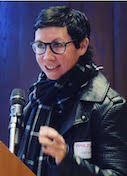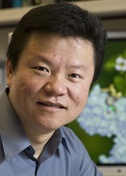Unstructured
A Brief History of CCP4
Published December 12, 2012
Sit down in front of a newly installed copy of CCP4 today, and you will find approximately 250 computer programs for solving protein structures. The list of programs includes several with catchy names, such as beast (for molecular replacement), dimple (for ligand identification in difference maps), crank (for experimental phasing) and buccaneer (for model building), and some cryptic, such as seqwt and npo. Nearly two dozen applications support file manipulations and format conversions. Still more are riders-on, either deprecated or unsupported.
The seeming mishmash is so by design. "CCP4 has always been a very loose collaboration," says Phil Evans, a structural biologist at the Medical Research Council Laboratory of Molecular Biology in Cambridge, UK, and one of the earliest members of the team that created CCP4 in 1979.
CCP4 stands for Collaborative Computing Project Number 4, the fourth effort in a series of 14 projects originally funded in the late 1970s by the UK's Science Research Council. The CCP projects were designed to support collaboration between researchers developing software for science and to provide shared access to expensive hardware. Today, CCP4 has around 2 million lines of code, dozens of active contributors and thousands of users worldwide, including expert crystallographers, academic researchers interested in solving structures, and scientists doing drug development at pharmaceutical companies.
Out of Necessity, Invention
CCP4 got its start in the 1970s when a number of new macromolecular crystallography groups spawned from the pioneering labs at the Laboratory of Molecular Biology at Cambridge and the biophysics department at Oxford. These two labs had developed a tradition of researchers developing methods, writing programs and sharing code.
But as the number of labs increased, the crystallographers became more far-flung. Being so far apart, they were missing out on collaboration, code sharing, and corrections. "You need someone who'll shout at you and say look, that's a stupid result, you must've done something wrong," says Eleanor Dodson, an early CCP4 member who moved from Oxford to the University of York in 1976.
When the late David Blow, a creator of X-ray crystallography, moved from Cambridge to London, he found scant computer facilities. He and Sir Tom Blundell, also head of a London lab, realized the crystallography community needed to find a new way to work together. They followed the lead of other groups and established a crystallography CCP.
This initiative couldn't have been more timely. The original CCP4 grant covered the cost of one person to coordinate program sharing between the crystallographers. "People were solving structures, so there were a lot of programs around, but they often didn't talk to each other very well," says Evans. Early discussions involved agreeing on common data formats.
From these talks emerged the philosophy that still underlies CCP4 today. Rather than integrate all of the programs into one tightly coupled system, CCP4 is a collection of free-standing programs that share data through files with standard formats.
A Structure Emerges
Now supported by the Biotechnology and Biological Sciences Research Council (BBSRC), the aim of CCP4 has not changed, though its purview has widened. Crystallographers from around the world now contribute their programs to CCP4, such as Amore from a developer in France and Crank from The Netherlands.
New contributions are reviewed by a panel of academics representing CCP4 users and assessed for technical suitability by the Core Team, which may suggest modifications. "We have become a little bit picky," says Eugene Krissinel, who is CCP4 Core Team Leader and responsible for maintenance and support. "Managing a collection of 250 programs is quite a chore."
When a submission falls through, which happens to about 1 in 10 programs, it typically happens during license negotiations. Though CCP4 only requests non-exclusive rights to distribute, governmental and institutional regulations sometimes raise insurmountable barriers.
CCP4 also has an Executive Committee, a group of twelve researchers that oversee the work of the Core Team, assess progress and provide direction. The CCP4 Core Team operates out of the Science and Technology Facilities Council Rutherford Appleton Laboratory in the UK. The seven-person team manages infrastructure, packaging, maintenance and support.
Recently, a group at CCP4 headquarters launched CCPEM, an independent initiative that will focus on electron microscopy. Free electron laser technology has also captured the groups attention, but an initiative has not yet begun. CCPN, for Nuclear Magnetic Resonance technology, is run independently out of Cambridge University.
New Developments
More and more often, crystallography is being done not by people who are crystallographers but rather by biochemists, molecular biologists and medical chemists who want to solve biological problems. Recognizing this trend, the Executive Committee has prioritized automation and validation to assist those who are not expert crystallographers.
Given this strategic direction, the CCP4 Core Team and funded developers at the University of York are putting a major effort into updating CCP4's aging user interface, which was developed a decade ago. The new interface aims to improve its appearance and usability, reducing user intervention, increasing automation and improving validation. "Ultimately, the idea is that you've got some data, you press a button, and a structure spits out the other end," says Evans. "The programs will decide what's best and also say, hmmm, something's wrong here."
Even though the process of solving structures is mature — "if you can get a good crystal, we can solve it," says Evans — getting a good crystal is often difficult. "There are pathological cases. Things can go horribly wrong."
Still, users with bad data still want to answer their biological questions. This puts pressure on developers to constantly retool their programs to squeeze more meaning from bad data. "This work is always going on in the background," says Krissinel. "It is the essence of CCP4."
Education has also always been a CCP4 priority. The CCP4 community is there to help both new and experienced users with an online forum, workshops held throughout the world, and a Study Weekend held in the UK each January where crystallographers gather to exchange ideas and learn new ways of doing things. "People in our field love methodology," says Dodson. "They really appreciate where things can be improved and like to improve it."
--Elizabeth Dougherty



























































































